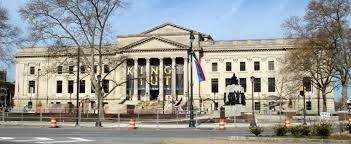The Franklin Institute
Introduction
Text-to-speech Audio
Founded in 1824 as the Franklin Institute of the State of Pennsylvania for the Promotion of the Mechanic Arts, the Franklin Institute is one of the oldest centers dedicated to science education and progress in the United States. In the Institute’s founding days, it offered classes on mechanics, engineering, and other such fields of scientific study in order to broaden people’s understanding of and engagement in the sciences. After a century of activity, the Institute became a museum in 1934 in order to expand its vision of promoting the sciences. Today, the Institute still serves that goal as a museum, reaching out to those who wish to learn through exploring exhibits, attending classes, and much more. Additionally, one may find in the museum’s rotunda the Benjamin Franklin National Memorial, which sports a 20-foot-tall marble statue of the scientist and Founding Father.
Images
Franklin Institute

Backstory and Context
Text-to-speech Audio
The Franklin Institute was originally founded in 1824 by Samuel Merrick and William H. Keating as the Franklin Institute of the State of Pennsylvania for the Promotion of the Mechanic Arts. In conjunction with the movement to enact educational reform in America and to help the nation progress through technology, the Institute was opened as a center to honor the memory of Benjamin Franklin and to continue to develop his inventions in innovative ways. The Institute, for its first century after its founding, served this purpose by providing classes in mechanics, engineering, and drafting in order to help bring science and invention into the forefront of those attending. Additionally, the Institute housed numerous technological exhibitions in this span of time.
The Institute shifted gears in 1930, attempting to raise money in order to expand and build a memorial hall and a science museum. Despite the financial toll the Great Depression had on the United States, the Institute raised $5.1 million, which allowed them to begin construction for the planned expansions. In New Year’s Day of 1934, the Franklin Institute opened itself to the public as a museum of science, allowing its patrons hands-on experiences that allowed them to learn about the world around them. Over time, the Institute continued to expand, adding to itself the Tuttleman IMAX Theater, and the Fels Planetarium, one of the oldest planetariums in this hemisphere. Additionally, the Institute houses the Benjamin Franklin National Memorial in honor to its titular scientist and Founding Father.
Today, the Franklin Institute still works to serve the community by providing hands-on scientific learning experiences for those who walk through its doors. In it, visitors may find exhibits on such topics as King Tut, neuroscience, traveling exhibitions, and other world-class exhibits. In addition to serving as a memorial and a museum, however, the Franklin Institute provides grants to researchers it deems worthy, and also publishes scientific papers to further research and knowledge within the scientific community.
Sources
https://www.fi.edu/about-us/mission-history http://www.encyclopedia.com/topic/Franklin_Institute.aspx
